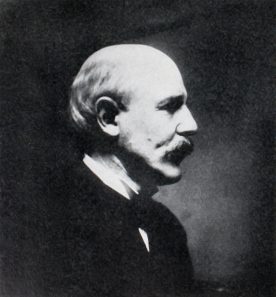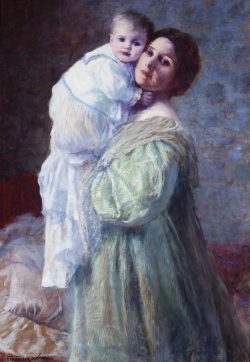Frederick W. Freer, from a photograph reproduced in Frederick W. Morton, “Frederick W. Freer, Painter,” Brush and Pencil 8 (Sept. 1901).

Frederick W. Freer 1849–1908
Son of a distinguished Chicago physician who served as president of Rush Medical College, Frederick Warren Freer was encouraged to take up art after a childhood illness left him partially deaf. His parents took Frederick and his sister Cora to Munich in 1867 to study at the Royal Academy, then a popular art school for Americans. He began sending work to exhibitions at the Chicago Academy of Design (predecessor of the Art Institute of Chicago) even before the family returned home, only weeks before the Great Fire of 1871. Two years later, Freer exhibited in the first Interstate Industrial Exposition art exhibition, and in 1876 he was elected to the Chicago Academy of Design, a mark of his rising local reputation.
On a second sojourn in Europe, between 1877 and 1880, Freer associated with some of America’s leading expatriate artists, notably Frank Duveneck, an influential exponent of the Munich style, and William Merritt Chase, an American pioneer of impressionist painting. On his return to the U.S., Freer settled in New York City, became active in numerous artists’ organizations, and exhibited widely. He worked in every genre of subject matter and explored a variety of media, including etching, pastel drawing, and watercolor painting; in the late 1880s he was even in demand as a book illustrator. Following a third trip abroad, Freer taught at New York’s Art Students League. With his marriage, he began to specialize in images of women and children, for which his wife and the couple’s six children frequently served as models. The successful exhibition of one such work brought Freer election as an associate member of the National Academy of Design in New York, and in 1889 he was represented in the Exposition Universelle in Paris.
Possibly to take advantage of Chicago’s plentiful art opportunities, Freer returned home in 1890. Thereafter, he adopted the brighter colors and distinct brush strokes of impressionism in some of his figural works and painted landscapes outdoors and on site, according to impressionist practice. Freer was a beloved instructor at the Art Institute, where he began teaching in 1892. Busy with local portrait commissions, he continued to exhibit nationally and to serve on juries, including the national art jury for the 1893 World’s Columbian Exposition in Chicago. At the exposition he won a medal; other honors were awarded to his work in exhibitions at the National Academy, the Art Institute, and other venues. Freer was among a handful of artists of his generation who maintained a national presence while living in Chicago: “One of Chicago’s Own Boys—He Was Born Here and His Pictures Are Known the World Over,” trumpeted a headline in the Chicago Evening Post in 1891.i The artist’s successful career was capped by a retrospective show presented at the Art Institute in early 1906, two years before his death at age fifty-eight.
Wendy Greenhouse, PhD
i “Paints Sweet Faces,” Chicago Evening Post, undated clipping, circa Jan. 18, 1891, in Art Institute of Chicago Scrapbooks, v. 5, Ryerson and Burnham Libraries, Art Institute of Chicago.
